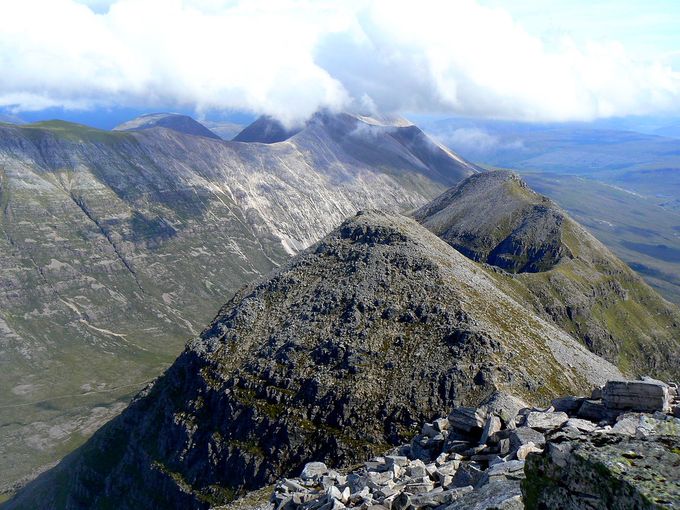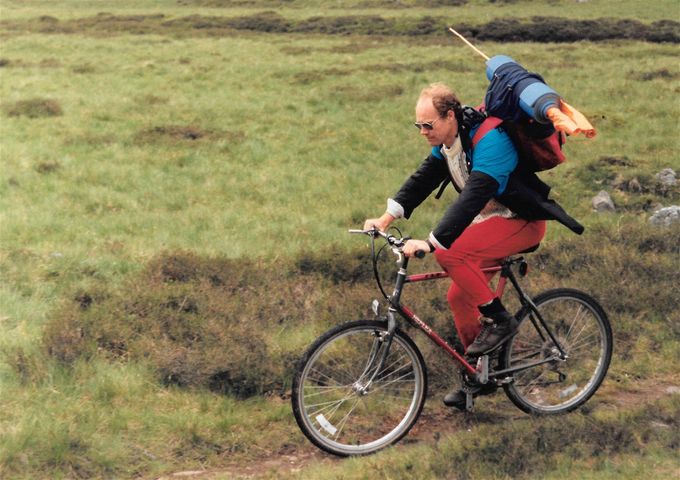1990 - 1993 COMPARISONS
Beinn Eighe from Liathach. Photo tms.nickbramhall
Partly with the thought of others attempting to beat our record I note some differences.
It is no criticism of Tony at all when I suggest that we did some things better. He was the instigator of the idea and magnificently planned the initial route and logistics from a standing start. Where I made successful changes I was merely building on his work.
THE ROUTE
Both years the start was in the Cuillins which made certain that they would be done in the daytime, and also allowed for a delay to the start in the event of impossible weather. In 93 we did delay 1 hour and seriously considered a delay of a day or 2.
In 90 we went for a finish in the south making it easier for most to get home should the relay be into the second weekend. In 93 running into a second weekend was not considered, so a finish in the north was sensible as it had far less driving time.
In 93 I planned the route and placed changeovers on it without deviation thus shaving more minutes off the time. I also had a strict criteria of maximum leg length (22 miles and maximum climb 3000 metres). Whether or not this was sensible I am not sure. There were a couple of very remote walk in changeovers, (both of which Ifor had,) into Knoydart and Fisherfield. I also had massive distance in and out to my Cairngorm leg, albeit the bike made things much easier at both ends.
SUPPORTING INCOMING RUNNERS
In 90 there was an allocated team member to support the incoming runner at the end of every leg/walk out. This involved providing some food and drink and simple emotional support. We all thought this was a good idea, but I found the practice was flawed. In reality people weren't prepared to wake up from much needed sleep to do this, but in turn the incoming runner could be very annoyed as the promised succour generally didn't happen at the times they most wanted it. This was the cause of many ructions that occurred.
In 93 this idea was simply scrapped - we discussed it before the relay and decided that runners finishing when people were asleep would have a reheatable meal left out for them and would get on as quietly as possible.
The team got on brilliantly with no ructions. This may have had something to do with the make up of the teams, but I don't think so. I was in both teams and it felt completely different crawling into the mothership exhausted and wet, but determined to get some sustenance without disturbing the others, than it had arriving and expecting, and not getting, things to be done for me. Also in 90 Dave who is the most genial guy got absolutely furious stemming from just this frustration.
COPING WITH THE NIGHT
In conjunction with the scrapping of the buddy support above, it was decided that the plan would be followed regardless of time of day. If the mothership had to move overnight then Colin would get up and drive it to the next destination. This meant that there was never any replanning necessary to work out how to get through the night resulting in someone not knowing the plan for themselves as happened more than once in 90.
THE SCHEDULE
Tony drew up a fantastic plan in 90 thinking deeply into what would happen. This did not include full instructions for every individual and also there were 2 sections left unplanned until near the time – firstly around the trip to Mull which had to happen during ferry times, and secondly in the last 24 hours.
In 93 I built on his work, firstly planning the whole relay, including 3 separate plans for Mull and the legs around it, so that the decision on which plan we were to use was made at the end of Gulven leg.
I also noted trigger points throughout, so that a runner appearing at the end of a leg/ walk out set off a defined chain of activity (or not). In cases where movement of vehicles was not urgent the trigger was described as “at leisure” so that people could sleep for longer if appropriate.
A copy of this schedule in an appendix here.
I then created an individual schedule for each runner defining which vehicle to be with all times and highlighting all their trigger points. I remember being pestered on day 1 being asked “what do I do now?” I referred to their schedule each time, and Craig said to me in the evening, “I see, it's easy. All I have to do is follow the schedule.”
I think it was crucial to the fact that nothing went wrong, although Ross, whose constant disappearing with Julie was obviously not in the plan, got close to not being in position at times. Nevertheless, when he had a trigger point to be in a vehicle he was always there. I think that had he not had his individual plan there would have been some real disasters.
The lesson here for any future attempts is that it is just about impossible to overplan.
SOME MINOR DIFFERENCES
The transit vans that we hired and fitted out for sleeping and cooking in were different. In 1990 we had a wide wheelbase vehicle enabling us to put 2 mattresses lengthwise in the vehicle. In 1993 we had a standard wheel base van and could only arrange the mattresses crosswise. This was a significant detraction, and resting in the back was nearly impossible as any hard braking and you'd roll off forwards.
With modern legislation the whole transport issue would need a significant rethink as sleeping in the back of moving vehicles is clearly illegal now.
In 1990 Tony produced flags which we used at changeovers to make it easy to spot where the new runner was. These were made from bright orange farming feed bags attached to a substantial bamboo pole. These worked really well and felt indispensible. Sadly these flags were used by a climbing relay a year later, and lost to Tony.
In 1993 Mark, I think, agreed to make some flags but as soon as I saw these I realised they were not going to do the job. Not much more than a foot high and not glossy coloured they were hard to see. I didn't use them from the start and their usage dwindled throughout. Having found Graeme in pitch dark at a stream junction after leg 10B it was only later that Graeme told me he had put out flags, neither of which I had seen. Somehow we got by without flags or changeover problems.
Nowadays we would use GPS so probably flags are not important.
Tony on a bike with a couple of the flags we used in 1990. Photo Rob Howard
Share this page

